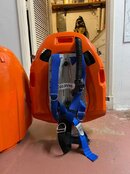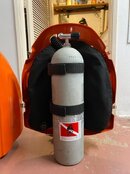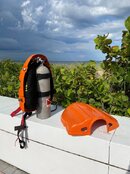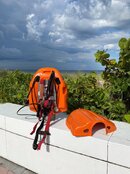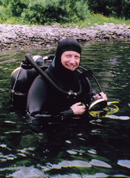jadairiii
Contributor
- Messages
- 1,377
- Reaction score
- 2,101
When the weather turns bad, and you have idle hands, well, your mind starts to wander….If any of you owned and dived an At-Pac for any length of time you will know it was a great piece of dive gear for it’s time. It had its flaws, but overall, way ahead of its time. I used one for close to 30 years until I switched to a BP/Wing. One of the things I loved about the At-Pac was the Fairings. I have two, they were the ultimate “cool”, although not real practical. That said, I got to thinking about how I could retrofit one so I could use my standard rig/backplate. Quick switch and I’m diving in style.
First, understand that the fairings could only be used with a steel 72 due to the geometry of the At-Pac so that was my first goal was to see if I could get an 80 to work. The opening at the bottom was just large enough. Second problem, larger yokes and yoke screws created a problem when using a fairing, you had to move the fairing up high enough so it could close (you see older ones with a telltale crack up high). And third, a doughnut wing would not work, I would need a horseshoe wing.
With that in mind, I used a Halcyon STA and mated it to one of my DIN 80’s. I then fabricated two brackets to hold the fairing between the STA and BP (cross brackets). Remember that the fairing laced on to the At-Pac. That worked but since my BP was now away from the fairing, that fairing was not stable. Easy fix was to make two rubber wedges between the BP and fairing. I also found a 40lb wing (Revo) that works better than the original At-Pac 60lb lift wing! I have to say, the result was better than expected. Tested it in the pool and works great. Next test will be a beach dive. Nice thing is now I can use my standard rig, everything in the same location…..and I look super cool!
First, understand that the fairings could only be used with a steel 72 due to the geometry of the At-Pac so that was my first goal was to see if I could get an 80 to work. The opening at the bottom was just large enough. Second problem, larger yokes and yoke screws created a problem when using a fairing, you had to move the fairing up high enough so it could close (you see older ones with a telltale crack up high). And third, a doughnut wing would not work, I would need a horseshoe wing.
With that in mind, I used a Halcyon STA and mated it to one of my DIN 80’s. I then fabricated two brackets to hold the fairing between the STA and BP (cross brackets). Remember that the fairing laced on to the At-Pac. That worked but since my BP was now away from the fairing, that fairing was not stable. Easy fix was to make two rubber wedges between the BP and fairing. I also found a 40lb wing (Revo) that works better than the original At-Pac 60lb lift wing! I have to say, the result was better than expected. Tested it in the pool and works great. Next test will be a beach dive. Nice thing is now I can use my standard rig, everything in the same location…..and I look super cool!



